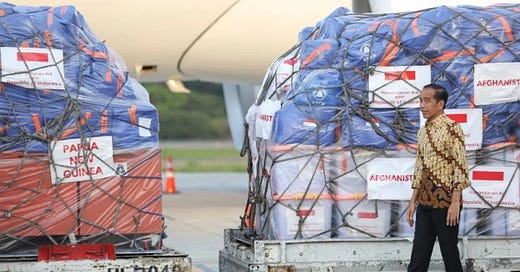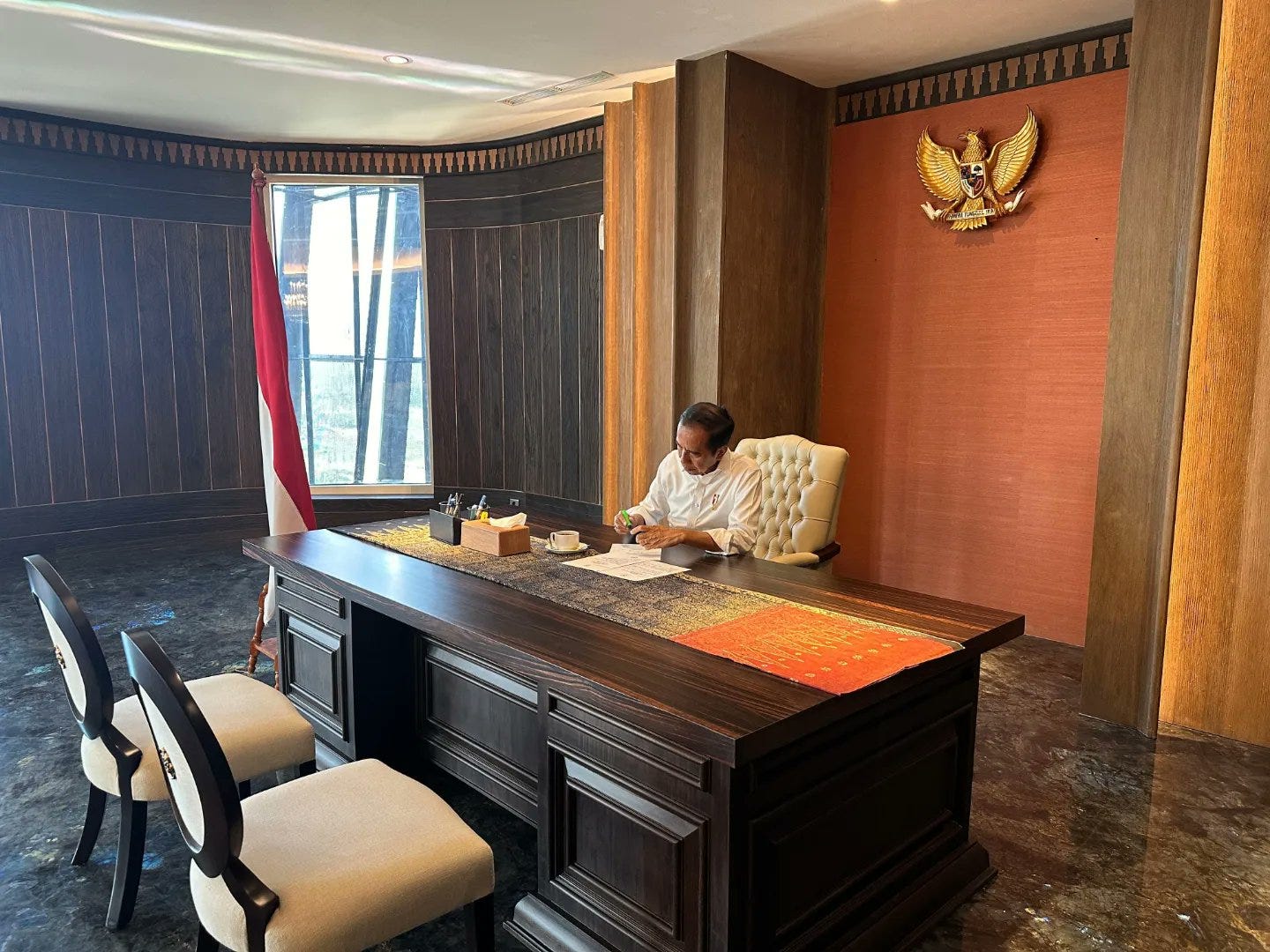Indonesia’s ‘Perfect Storm’ of Debt
A decade of headlong development comes home to roost
Undaunted by construction delays, lack of funding, and land acquisition problems, Indonesian President Joko Widodo has moved his office to his new administrative capital in East Kalimantan 1,300 km across the Java Sea, expressing satisfaction at the progress on the US$33 billion project, hardly more than two months before he is scheduled to leave office after 10 years at the head of the government. It remains to be seen if the 12,000 civil servants due to run the new capital follow eventually, or whether Nusantara, as Jokowi dubbed it, will end up a monumental folly.
There are reasons to be concerned. Indonesia, according to financial analyst Adityo Hutomo Sitepu, writing on April 21 on LinkedIn, faces what he called “a perfect storm of debt.” In early July, the state-backed principal contractor PT Wijaya Karya, which is responsible for construction of the new capital, said it had suffered major financial woes, blaming them on the interest burden generated by the US Federal Reserve and losses from the construction and operation of the Jakarta-Bandung high-speed rail (HSR) line, which operates under the Whoosh brand, which it also built, and which was hit by major cost overruns and delays, and now diminishing ridership.
As Asia Sentinel reported on June 5, Bambang Susantono and his deputy Dhony Rahajoe, the head and deputy head of the Nusantara Capital Authority (IKN) abruptly resigned just two months before the planned 79th Indonesian Independence Day inauguration on August 17, adding to questions whether the president’s visionary plan would ever come to fruition.
The problems run much deeper than just Nusantara, where a gala on August 17 ceremony has been scaled back and won’t include foreign dignitaries because of the limited infrastructure available. The airport isn’t ready for aircraft landings.
After a decade of headlong infrastructure spending on roads, airports, ports, and other infrastructure as Jokowi sought to modernize his country, Indonesia is debt-strapped and there are real questions whether incoming president-elect Prabowo Subianto, who takes office on October 20, will fulfill the pre-election promises he made to make Jokowi’s dream a reality, or whether he has other priorities. For one thing, Prabowo has publicly committed to his own campaign promise of a US$30 billion free lunch program to feed 82.9 million school children to combat stunting, which affects one of every five Indonesian children. In addition, Coordinating Economic Minister Airlangga Hartarto recently said the government is studying building a US$60 billion seawall across Jakarta Bay to alleviate tidal flooding and land subsidence in the face of global warming, backed by Prabowo. "We are preparing the study, and we will continue this," Airlangga told the government news service Antara.
But all of the figures for Nusantara, the lunch program, and the sea wall may be written in water. Indonesia is legally required to keep annual fiscal deficits capped at 3 percent of GDP, and total public debt below 60 percent of GDP. In the current year budget, according to development expert James Guild, writing in The Diplomat on June 25, the deficit is expected to come in around 2.3 percent and total debt is currently below 40 percent.
PT Kereta Cepat Indonesia China (KCIC), the consortium responsible for the operation of the high-speed rail concern Whoosh, expects the service to face a deficit of Rp 3.15 trillion (US$200 million) in its first year of operation.
Analysts say the deficit may continue for decades and will likely affect the SOEs behind the project, particularly railway firm PT Kereta Api Indonesia (KAI), which holds the largest stake in the railway on the Indonesian side. This year, KCIC expects to book Rp2 trillion in revenue, more than 95 percent of which is projected to come from ticket sales. However, it will have to spend Rp 3.32 trillion to operate the service and another Rp 1.84 trillion to pay down loan interest and meet its tax obligations, according to a financial document seen by The Jakarta Post.
“It's very simple,” said a western businessman based in Jakarta. “Jokowi used the SOEs for his infrastructure wet dreams and in the process let the debt build up.”
Now the SOEs are running out of the ability to pay and the government will have to bail them out or stop building huge projects. Estimates from 2023 suggest that Indonesia's six biggest construction SOEs collectively faced debt over Rp1,000 trillion (US$62.8 billion), an average of US$11.3 billion per company, which is likely to severely limit their ability to invest in new projects and technology.
Then there is the ever-present issue of corruption, an Indonesian government permanent affliction. On June 24, PT Danareksa President Director Yadi Jaya Ruchandi told a House of Representatives committee that of 14 SOEs under scrutiny, six are at risk of being dissolved due to financial issues. One of those state-owned companies in trouble is Garuda Indonesia, the Indonesian Flag Carrier, which from 2009 to 2021, “decided to procure 50 new aircraft from Boeing and an additional 10 units from Airbus,” according to an analysis in the European Journal of Law and Political Science, which noted that “ “This step is great, but some people obtain personal advantages from the transactions.”
“This debt burden is squeezing profits,” wrote financial analyst Adityo. “In 2022, net profit margins for these companies hovered around 3 to 5 percent, a far cry from the double-digit figures they enjoyed a decade ago. This financial strain makes it difficult for SOEs to reinvest profits into upgrading their equipment and workforce, potentially hindering their competitiveness in the long run. Meanwhile, Indonesia's infrastructure spending is projected to reach Rp7,000 trillion (US$483 billion) between 2022 and 2024.”
So how did these SOEs end up so deep in debt during a period of booming infrastructure investment? Adityo cited these factors:
Aggressive Bidding: Facing stiff competition from domestic and foreign firms, SOEs have often submitted aggressive bids for projects in order to secure contracts. While this strategy might win them projects, it often comes at the cost of razor-thin profit margins, as project costs can escalate due to unforeseen circumstances.
Project Delays: Bureaucratic red tape and unforeseen challenges like land acquisition issues can lead to project delays. These delays can be disastrous for SOEs, as they continue to accrue debt while project completion and revenue generation stall.
Limited Funding Options: Relying heavily on bank loans, SOEs are exposed to rising interest rates, making debt repayment even more difficult. This makes them vulnerable to fluctuations in the financial market and limits their ability to explore alternative financing options.
The future of the construction SOEs hinges on their ability to navigate this financial tightrope, Aditya wrote. The SOEs must collaborate with private companies for fresh capital and expertise for project execution. Projects must be reevaluated with a more critical assessment of bids and project feasibility. Government intervention might be necessary to restructure debt and provide these SOEs with some financial breathing room. They must implement stricter cost controls and improve operational efficiency to free up capital for debt repayment and investment.





